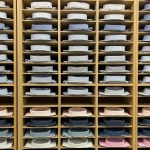
Declutter and organize your closet according to color, occasion, and season and never be at a loss for something to wear.
Unfortunately, I’ve had to declutter my closet a few times.
Once in my late teens when I couldn’t decide who I wanted to look like: my conservatively dressed father or the rock star Billy Idol? As a result, I had a closetful of mismatched garments.
Then there was the phase after my divorce when I kept buying new clothes instead of doing the laundry.
And most of us have had times in our lives when we’ve let things pile up. Before we know it, our closet contents are largely unknown and there’s no room for new purchases. That’s when the overflow begins.
In this post, I’ll tell you how to clear up the mess and how to prevent it happening again.
What You Should Have in Your Closet
The key to an organized closet is keeping it manageable.
It means having no more than you need with every item earning its place. But this has nothing to do with minimalism.
I have 20 dress shirts of various patterns and colors to ring the changes, at least one tie for every shirt, 15 polo shirts, and underwear to last me three weeks in case I don’t do the laundry.
On the other hand, I have only two suits, two pairs of jeans, two pairs of chinos, three fine-knit cardigan sweaters, and two pairs of shoes. My outerwear is limited to an overcoat, a down jacket, and a windbreaker.
This serves for every occasion, whether worship, work, or play.
If you practice sport, socialize frequently, or are particularly fashion conscious, you probably need a lot more.
Don’t try to get by on less since you’ll end up binge purchasing later.
Decluttering Your Closet Step-by-Step
In recent years, Marie Kondo has inspired millions. But her KonMari tidying method isn’t for me.
Folding is beyond my capabilities, so I hang my shirts. The only closet organizers I possess are Ikea’s “Skubb” for my socks and underwear, and the “Komplement” multipurpose hanger for ties and belts. As for “sparking joy”—it doesn’t resonate with me.
But like her, I believe in emptying the closet before decluttering.

1. Empty and Clean the Closet
Take everything out of the closet and lay it on your bed. Items that don’t crumple belong at the bottom of the pile, with your crisply ironed shirts at the top.
If you want to be able to get into bed by nightfall, start in the morning and set aside the entire day.
2. Return Your Clothes to the Closet in an Organized Manner
After you’ve vacuumed and wiped down the closet, you can refill it. But only with items that fulfill the following criteria:
- They are appropriate for the current season.
- They are in good condition: no signs of wear, no fading, and no yellowing.
- They fit you.
- They coordinate well with the rest of your wardrobe, both in color and style. If not, do you wear them regularly?
- You’ve worn them during the past year.
As you return items, form separate piles for those that don’t pass the test: out-of-season; not in good condition; do not fit; do not match anything else; haven’t been worn in a year.
Sort According to Casual and Formal
To save you time when putting together an outfit, sort according to casual and formal.
For example, formal includes suits, cloth trousers, and dress shirts. These I position on the right side of the rail. Jeans, chinos, and polo shirts are casual and occupy the left side and some shelves.
Sort According to Colors
Sub-sort into colors.
I don’t have to do this since my wardrobe consists predominantly of cool and neutral tones; everything coordinates.
If you like both cool and warm, separate these. This will allow you to mix more strategically.
Warm colors are based on yellow, orange, and red, while cool colors are based on green, blue, and purple. Gray is neutral but may have a warm (yellow) or cool (blue) undertone.
How My Wardrobe Works
As an example of how this works, my two suits are in neutral black and gray. I wear them twice a week to worship and sometimes to work.
The black suit jacket also functions as a blazer, which I wear with the gray suit trousers or a pair of jeans, depending on the occasion.
Instead of the suit jackets, I often team the trousers with one of my V-neck cardigan sweaters, which are in burgundy, navy, and gray. These I can wear with a dress shirt and tie, or casually with a polo shirt and jeans or chinos.
As you can see, each item corresponds with several others; think about this when decluttering your closet.
3. Put Out-of-Season Clothes Into Storage
Of the remaining piles, you should only want to keep clothes that are out-of-season.
Pack them away in vacuum-sealed bags (also called “space bags”) until the weather changes. These can be stored in the attic or cellar without fear of dampness or moths.
Items with a “dry clean only” label should go to the cleaners beforehand. This prevents spillages and particles from setting, which may cause permanent stains and discoloration.
By the way, before sending cloth trousers to the cleaners for the first time (these may also be part of a suit), let down the hem in case of shrinkage. It prevents the hard line that appears if you have to let them down afterwards.
4. Discard the Clutter
Whatever is left is clutter.
Throw away items that are no longer in good condition; these are unwearable.
Those that don’t match anything else in your wardrobe or that you haven’t worn for over a year should be given away.
You have to be ruthless; there’s no place for sentiment. Although I’ve had reservations about discarding good clothes simply because I haven’t worn them, I’ve never missed them after the deed is done.
If you want to keep clothes that no longer fit with the intention of losing weight, put them into storage with your out-of-season items. If they’re still too small after a year, discard them.

Keeping Your Closet Organized
Decluttering your closet is only half the battle. Now you need to keep it that way.
If you manage your wardrobe properly, your clothes will last longer. This is great if you’re like me and detest shopping.
Selecting the Right Clothes
But shopping is where good wardrobe management begins.
Pay attention to quality above quantity. This doesn’t mean spending exorbitantly; in the UK I buy at Marks and Spencer, and at C&A in continental Europe.
As well as value for money, these stores offer classic designs that won’t go out of style too quickly. This is important if you plan to keep your clothes for a long time.
You should also be able to team new items with clothes you already have. As we’ve already seen, clever mixing and matching creates a versatile wardrobe, allowing you to put together numerous outfits with fewer items.
Wardrobe Maintenance
Regular maintenance will save you money, keep you away from the stores, and prevent you from having to declutter your closet again. So set aside an evening every few weeks to appraise your wardrobe.
Make sure everything is in its place and check for items that need cleaning, mending, or throwing away.
Socks, underpants, and tank tops that are discolored or holey belong in the trash. If shirt collars are frayed, send them to a charity shop. Coats and suits may only need a brush down; if not, send them to the cleaners. Repair down-at-heel shoes if possible or replace them.
© 2025 J. Richardson
Related Posts
Disclaimer
The information provided by The Neat and Tidy Man (“we,” “us,” or “our”) on theneatandtidyman.com (the “site”) is for general informational purposes only. While we endeavor to keep the information up to date and correct, we make no representation or warranty of any kind, express or implied, regarding the completeness, accuracy, reliability, suitability, adequacy, validity, or availability of any information on the site. Under no circumstance shall we have any liability to you for any loss or damage of any kind incurred as a result of the use of the site or reliance on any information provided on the site. Your use of the site and your reliance on any information on the site is solely at your own risk.



